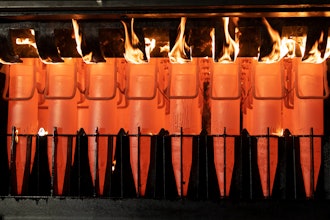
AirCorps Aviation in Bemidji, MN, restores and rebuilds award-winning vintage World War II aircraft for pilots and collectors throughout the world who want to own a piece of history. For AirCorps, the key is to deliver a truly authentic aircraft and experience to a discriminating and educated customer. That means perfecting every detail, right down to the smallest parts - the rivets.
In October 2011, AirCorps co-owner and parts manager Eric Trueblood began a challenging search for AN426 and AN442 solid aluminum rivets that appear historically accurate. The rivets could not have head markings, beyond a dimple that indicated material type, or protective chromate film commonly found on modern aluminum rivets.
"We needed historically accurate rivets made to the original standards," Trueblood said. "We wanted to achieve a look of an aircraft that has just come off a World War II aircraft assembly line."
AirCorps' search for vintage, certified rivets turned up empty, so Trueblood chose to find a rivet manufacturer that could make historically accurate custom rivets.
"We came to the conclusion that we were wasting our time and resources hunting down old rivets that often didn't come with certification," he said. "Plus, we had a preference for new parts. There's something about putting in a fresh rivet that hasn't been sitting on a shelf for 60 years."
Riveting History
AirCorps Aviation contacted National Rivet & Mfg. Co. in Waupun, WI, a manufacturer of rivets that specializes in custom orders, including vintage parts. National Rivet was a supplier of aluminum aircraft rivets during World War II, and virtually all of the aircraft rivets for the American war effort came through its Waupun facilities. Since the factory was located far from the nation's coasts, the U.S. Dept. of Defense deemed it very safe from enemy bombing attacks. During the War, National Rivet earned a Navy E Award from the U.S. Navy for production excellence of war equipment.
"National Rivet made the majority of rivets used by Rosie the Riveter for the allied forces during the war," said Bur Zerasky, executive vice president, National Rivet. "However, because of the safe environment and high production standards, rivets from other suppliers were anodized, inspected, packaged, and distributed from the Waupun facility as well."
With a history of manufacturing and supplying so many rivets during World War II, National Rivet has records and drawings on all the old parts and their production parameters, making it possible to produce historically accurate parts today. AirCorps Aviation provided government specifications to aid in production.
"We actually had our machine blueprints for the parts in our files, so we knew the tooling that was required," Zerasky said. "Between the government specifications, which had the dimensions, and our internal production drawings, we had records of how to make the tooling and produce these parts."
Nearly 70 years after National Rivet provided parts for World War II aircraft, the company continues to maintain top aerospace rivet standards. National Rivet has received AS9100C certification for its quality management system, so aerospace organizations can be assured that National Rivet products and practices meet their exacting quality requirements.
AN Rivets for Sale
To get the most cost-effective price for the custom-made rivets, Trueblood knew that AirCorps Aviation would have to order in sufficient quantities. The company partnered with other aircraft restoration shops that were interested in vintage rivets to organize a batch that was large enough to justify the investment.
Now, AirCorps sells National Rivet's historically accurate rivets as an extension of their authentic parts offering. All parts must meet stringent criteria to match AirCorps Aviation's high quality standards, for which they are known in the industry.
"The accuracy of our restorations and quality of our craftsmanship are crucial, and National Rivet created a product that's consistent with our quality," Trueblood said. "We were willing to put our name behind the National Rivet parts, which is an important thing for us because we work in a small world with extremely high expectations. We've had parts customers who've been more than enthused about the rivets and liked that we could provide an assortment of products to fit the World War II aircraft look and spec."
Restoration Accuracy
Often, the exteriors of some World War II airplanes have less paint than modern ones. During the war, the aircraft exteriors were often unpainted to speed up the manufacturing process. In some cases, airplanes were painted for camouflage to match their intended use: aircraft flying over the ocean often had blue bellies, while those flying over vegetation often had green bellies.
AirCorps Aviation primarily restores airplanes with an Alclad finish, which features a thin, high-purity aluminum layer bonded to the aluminum core material to prevent corrosion, giving the planes a silver finish. Using rivets with a chromate film, which has a yellow or gold finish, would look out of place and not be acceptable to a discerning collector. To keep the vintage restorations authentic, AirCorps Aviation uses the same rivets used during the war: a clear anodized rivet (with an aluminum finish), a blue anodized rivet and a type 205 dichromate rivet (with a pale yellow finish).
"Rivet markings and color are not something that a large segment of the population would notice, but these aircraft are national treasures," Trueblood said. "Their history and makeup deserves to be honored. We are blessed to have customers who allow us to do just that, and vendors such as National Rivet us make it happen."
In some cases, those rivets might get painted over, but AirCorps can say with certainty that on its projects, the rivets are produced just as if they were made during World War II.
The riveting process for a vintage aircraft is labor intensive and requires attention to detail (view the 'Rivet Pounders' and other AirCorps team members). AirCorps Aviation works primarily on 2024 aluminum skins, which are anywhere from 0.02 mm to 0.19 mm thick. Setting the rivets requires two workers, one with the pneumatic rivet gun and one with the rivet set or 'bucking bar,' to communicate continuously. As one operator on the outside of the skin punches the rivet into the skin, an operator is inside the structure with a rivet set in place to compress the back end of the rivet so the skin adheres to the structure. This process is repeated tens of thousands of times for each aircraft.
"Riveting is an art form that takes craftsmanship," Trueblood said. "We can't have the metal marred with scratches or dents from the rivet gun. It takes experience to know when the rivet is properly compressed. We have incredibly talented craftsmen here. The rivets are something that people always look at on an aircraft. It's an inspection point. We are glad we have the National Rivet quality to help us achieve the look we want."
Currently, AirCorps Aviation's primary project is restoring a P-51 Mustang long-range, single-seat fighter plane, a WWII combat veteran named Sierra Sue II. The craft has an Alcad finish and several World War II combat markings for the 9th Air Force, 370th Fighter Group, 402nd Squadron, and Code E6-D. Lt. Bob Bohna was the aircraft's first pilot in 1945. Sierra Sue II was flown at the 2014 EAA AirVenture show in Oshkosh, WI.























